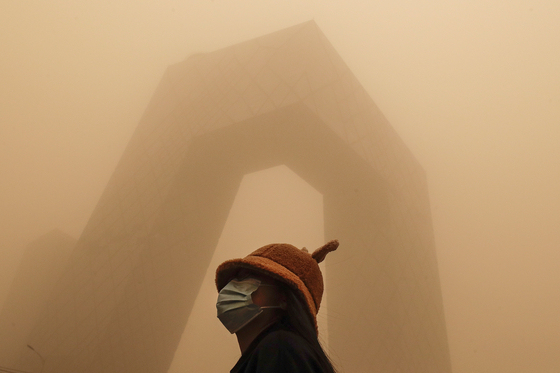
On the 15th, the sky in Beijing, China, covered with yellow dust, turned yellow. AP=Yonhap News
On the 15th, the concentration of ultrafine dust soared over 100㎍/㎥ across the country, centering on the metropolitan area. On the 16th, the yellow dust that covered the sky of Beijing, China is expected to flow into Korea through the north wind.
According to Air Korea, the Korea Environment Corporation, the concentration of ultra-fine dust (PM2.5) exceeded 100㎍/㎥ by 11 am in the metropolitan area and Chungbuk, where emergency measures for high-concentration fine dust were taken on the 15th. It exceeds the standard of’very bad’ (76㎍/㎥~).
Gojan-dong, Namdong-gu, Incheon, recorded a maximum of 157㎍/㎥, Bucheon, Gyeonggi-do, 120㎍/㎥, and Seodaemun-gu, Seoul, respectively. The concentration of ultrafine dust increased to 103㎍/㎥ in Asan, Chungnam, and up to 101㎍/㎥ in Jecheon-do, Chungbuk.

The state of ultrafine dust concentration in the country at 11 am on the 15th. Materials National Institute of Environmental Sciences
The National Institute of Environmental Sciences Air Quality Integrated Forecast Center said, “In the fine dust remaining the day before, additional fine dust accumulates due to atmospheric congestion, so the metropolitan area, Gangwon Yeongseo, Chungcheong area, Gwangju, Jeonbuk, Daegu, and Gyeongbuk are’bad’, and other areas are’normal’. ‘It is expected to be.’
Cold breeze blows out ultrafine dust, but brings yellow dust

The outbreak of yellow dust on the morning of the 15th. Since the 14th, yellow dust has originated over a large area near Mongolia and the Gobi Desert and is approaching Korea. Yellow sand is expected to reach Korea from the dawn of the 16th. Materials Meteorological Agency
From the dawn of the 16th, it adds to yellow dust. The Meteorological Administration said, “With a very strong wind of 50-70 km/h blowing in the vicinity of Inner Mongolia and Gobi Desert in China, yellow dust has been widely occurring from the 14th, and it will be very strong in some areas.” It is very likely to occur, and there is a high possibility that it will enter Korea from the dawn or morning of the 16th through the north wind.”
In Beijing, the capital of China, where yellow dust from Mongolia first reached, a yellow dust’yellow warning’ was issued for the first time this year. Due to the yellow dust, the concentration of fine dust (PM10) in Beijing was 1370㎍/㎥ at 8 am, and the concentration of ultrafine dust (PM2.5) was 223㎍/㎥.

The sky in downtown Beijing, China, when the yellow sand yellow warning was issued this year, looks yellow. This yellow sand is expected to reach Korea from the dawn of the 16th. AFP=Yonhap News
Fine dust’bad’ until the 17th

Bukaksan, seen from the middle of Gwanghwamun Square in Jongno-gu, Seoul, showing a level of’very bad’ with an ultrafine dust concentration of 83㎍/㎥ at 10 am on the 15th is obscured by fine dust, and only a faint outline is visible. Reporter Kim Jeong-yeon
The cold wind blowing from the northwest slightly dissipates the ultrafine dust accumulated until the 15th, but the air quality is expected to continue to show’bad’ as the yellow dust comes in immediately behind it.
Choi Won Air Quality Integrated Forecast Center forecaster said, “The high-concentration ultrafine dust accumulated by the wind blowing from the night of the 15th is slightly resolved, but since yellow dust continuously enters, fine dust (PM10) and ultrafine dust (PM2.5) ) The concentration will increase together,” he said. “Even if the yellow sand comes in quickly, the resolution is slow, and the effect is expected to continue until the 17th because it does not come in once and stops but continues to come in.”
There are some places where it rains a little from the evening of the 15th, but it seems to be less effective in reducing the concentration of fine dust or yellow dust. The Meteorological Administration predicted that weak rain would fall all over the country from the evening of the 15th to the 16th, starting from the coast of Jeonnam on the evening of the 15th. It is expected that rain of 10 to 40 mm in Jeju Island and 5 to 10 mm in Jeollanam-do is expected, but it is expected that rain of around 5 mm will pass shortly in most of the country.
Reporter Kim Jeongyeon [email protected]

![]()
